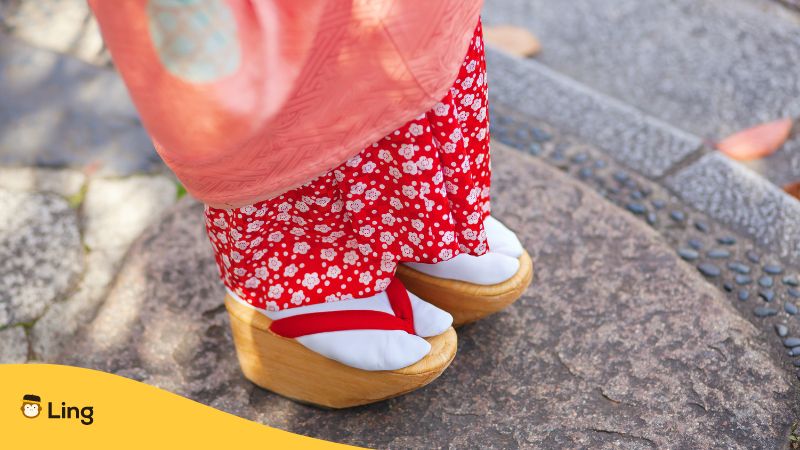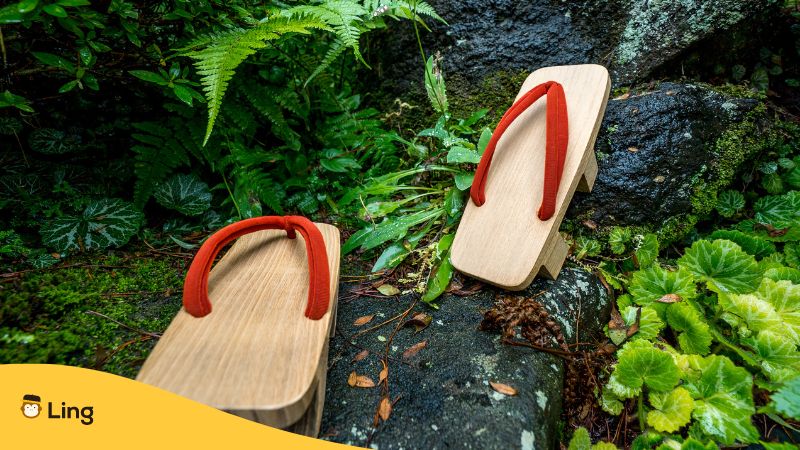They’re everywhere when you visit Japan – on city streets, temple grounds, and traditional inns. Perched on women’s feet as they walk gracefully in kimonos or adding height to men dressed in casual yukata. Yep, I’m talking about the Japanese geta (下駄) known for their signature “clack-clack” sound.
Beyond their funky look, geta has some cool backstories too that travelers should know. Like, their design going way back to help kimono wearers keep hems clean way back in the 8th century. And that learning to balance and walk gracefully in them takes skill! Think awkward apprentice geisha in training.
Want me to let you in on more need-to-know geta facts for travelers? Whether you just like admiring them on locals or secretly want to try wearing geta yourself, I’ve got 5 fascinating bits of history, culture, and even handy Japanese phrases to share. Who knows – you might even dare to walk a mile in these classic Japanese sandals after reading!
Table of Contents
What Is A Japanese Geta?
So what exactly is a geta sandal, you ask? It’s basically the footwear you’ll see paired with yukata lightweight kimonos during Japanese summer festivals and firework displays. But geta has been around way longer than that in traditional culture.
Unlike your basic flip flops that just have a flat sole and toe strap, geta has these three components: Dai (台), Ha (歯), and Hanao (鼻緒). The Dai is the flat base of the shoe. Ha, also meaning teeth, are the blocks underneath the sole. Lastly is the Hanao, which is the V-shaped cloth on top of the shoe.
Now here’s the tricky part – instead of slipping toes into the straps, geta are worn with traditional tabi socks. Kind of like white gloves for your feet. The Hanao then slips between the first and second toe to keep the geta securely on. Usually, men’s straps are black, while women’s are bright red.
These days, the Japanese sandals geta live on in the world of professional sumo wrestling more than anywhere else. The traditional footwear is still part of the official dress code for wrestlers when appearing in public. And get this – you can tell what rank a sumo wrestler is simply by what’s on his feet!
According to the Japan Times, the newest sumo recruits have to wear geta sandals when outside the ring. It’s only after proving themselves and moving up in rankings that wrestlers graduate to wearing seta (勢多) – a more casual, comfy cross between geta and slippers. And eventually, the highest-ranked wrestlers with real seniority get to wear just tabi split-toe socks by themselves!
Why Do Japanese People Wear Geta?
So why exactly do Japanese folks wear the classic geta? It’s a fair question – after all, shuffling around on elevated wooden platforms seems like an odd choice! But geta sandals actually have some great benefits that make them a versatile part of traditional Japanese footwear.
It may seem odd today, but those traditional Japanese shoes actually served an important purpose – protecting fine silk kimono hems from getting dirty! See, wealthy women during the 8th-century Heian era wore exquisitely decorated kimonos that could instantly get ruined by mud or dust. We’re talking hand-painted silk brocades with lengthy, trailing hems too.
By keeping the hem fabric elevated on wooden “teeth,” geta sandals prevented the delicate and priceless kimono lower half from sweeping the ground. The taller two teeth variety ensured ample clearance.
Along with protecting fine fabrics, traditional wooden geta sandals had sustainability benefits too. Being made from natural renewable materials like cypress, cedar, and lightweight paulownia wood qualifies geta as an original eco-friendly shoe! The mottainai (もったいない) custom of repairing and reusing older geta rather than discarding them also kept waste down. Passing down high-quality geta through generations as heirlooms were common as well.
When To Wear Japanese Geta Sandals?
In Japan, geta go hand-in-hand with summer yukata robes as a light, breathable pairing. Temple fairs, firework displays, cherry blossom viewings – anytime temps rise, geta come out. Their airy design suits hot weather while upholding tradition.
For travelers in Tokyo, you can also rent kimonos and getas while taking insta-friendly pics at the Asakusa Shrine (浅草神社). And trust me, the whole get up adds an authentic touch! Their gentle clacking echoes beautifully along temple walking paths too. Just watch your step on those smooth stones!
Wedding season also sees brides change into fancy geta to click down the aisle, showcasing intricate hanao straps. And a visit to hot springs or ryokan inns means swapping outdoor shoes for comfy lounge geta during your stay.
Is It Difficult To Walk In A Japanese Geta?
Admiring the graceful gait of others in geta is one thing. But is it actually difficult to walk on those elevated wooden platforms yourself? In a word – yes! No wonder why Chiyo from Memoirs Of A Geisha was trained with that first!
With practice, walking gracefully in geta is possible. But it takes conscious effort and strength in the calves and feet at first. Basically, mastering a smooth, gliding walk requires carefully placing each foot’s toes first, then quietly rolling from heel to toe. Easier said than done!
When I first tried it, I remember feelin’ like I was in a gym. I mean, balancing on the tall teeth bases alone engages core muscles. Well, I pretty much have no choice since it’s either I engage my muscles, or I end up twisting my ankles!
So here’s a recommendation: For tourists, opting for short one inch teeth geta offers more stability until achieving proficiency. And don’t be discouraged if your first attempts echo loudly like a herd of galloping horses!

5 Facts About The Japanese Geta Sandals
Oiran Geta Reach 20 Centimeters Tall
Catch a glimpse of an extra tall geta with 3 towering wooden teeth? At around 20cm, these impressive platforms are called Oiran geta, after the historic high-class courtesans of the Edo period who wore them. The extreme height advertised their social status and rank in the past.
Okobo Geta Make “Pokkuri Pokkuri” Sounds
Look for geta carved out of a single wooden block 10cm thick – those are Okobo style worn by maiko apprentice geisha. Young girls also don these sandals for coming-of-age ceremonies. Their repetitive “pokkuri, pokkuri” clacking sound walking mimics how they got their nickname!
Ama Geta Have Toe Covers For Rain
For Japan’s wet season, Ama geta with lacquered wood and a partial toe cover offers practicality. The taller teeth and covered toe keep feet dry, while the smooth, lacquered finish helps prevent slipping on slick surfaces. Best choice for drizzly summer strolls!
Metal Plates On Geta Soles Prevent Slipping
When snow falls, savvy geta wearers switch to styles with metal plates lining the sole. This extra grip lets wooden soles tread slippery streets without sliding. Long before snow boots, Japanese people relied on metal-bottomed geta to stand strong against winter weather!
Tengu Geta Keep Feet Above The Floor
Sushi chefs and market sellers often wore extremely high one-toothed Tengu geta in history. Why? The long single tooth kept their feet well above street garbage and mud back before sanitation. Form and function combined for these professional tradespeople!

Handy Japanese Geta Phrases
Adding some key Japanese vocabulary around geta shows good cultural manners. These phrases may come in handy browsing geta shops or when gifted a pair.
“Kore wa totemo kireida”
Japanese script: これはとてもきれいだ
Translation: “These are very beautiful.”
“Hajimete geta o hakimasu”
Japanese script: はじめて下駄を履きます
Translation: “Wearing geta for the first time.”
“Geta no shisei o oshiete kudasai”
Japanese script: 下駄の履き方を教えて下さい
Translation: “Please teach me the way to wear geta.”
“Geta no aruki kata ni tsuite shitsumon ga arimasu”
Japanese script: 下駄の歩き方について質問があります
Translation: “I have a question about how to walk in geta.”
“Geta wa watashi ni totte muzukashī desu”
Japanese script: 下駄は私にとって難しいです
Translation: “Geta are difficult for me.”
“Geta ga watashi no ashi o atsukatte imasu”
Japanese script: 下駄が私の足を圧迫しています
Translation: “The geta is hurting my feet.”
Ready To Try Out Modern Geta Sandals?
As you can see, there’s more to Japanese geta sandals than meets the eye! From protecting priceless silk kimono to declaring status in past centuries, geta has fascinating backstories. Even today, they connect wearers to tradition and sustainability.
Hopefully, learning origins, styles, and phrases demystifies geta for visitors. Whether you’re browsing Tokyo antique stores or sightseeing in summer robes, get add spirit. Clack proudly across shrines and gardens with new insight.
And for travelers eager to unlock more of Japan’s rich culture, language is key. Apps like the Ling app let you build practical Japanese vocabulary at your own pace. Inside, every lesson covers everyday phrases beyond geta terms to truly engage locals and customs. Give it a go today!



































































